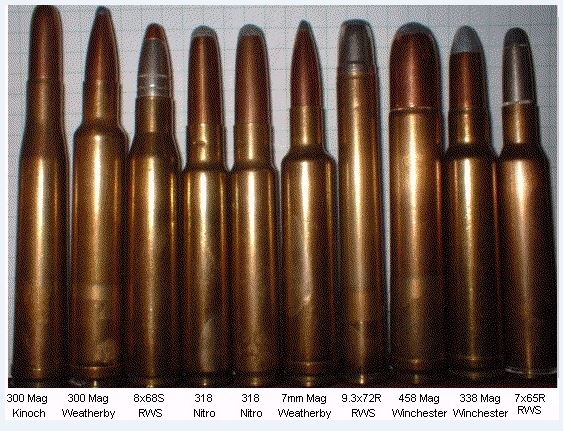From Mr. Free Market comes this gem from the past, a Westley Richards takedown rifle, based on a Mauser 98 action:

Westley Richards & Co. has been around since the early nineteenth century, making them one of the oldest gunmakers extant. They have made both rifles and shotguns, the latter including models designed by the brilliant gunsmith John Deeley (which I’ll talk about some other time).
But that’s not what I want to talk about today. Rather, I’d like to talk about their proprietary cartridge, the .318 Westley Richards (or as it’s more commonly known, the .318 Nitro), which came onto the market around 1907/08. Here’s a pic (from Wikipedia) which compares the .318 to other, more famous medium-game cartridges:

Note the long, thin(-nish) 250-grain bullet*, akin to the 7x57mm Mauser (a.k.a. .276 Rigby) and the 6.5x55mm Swedish bullets. This gives the .318 exceptional penetration, and given the times it was popular, it should come as no surprise that the .318 Nitro has felled more elephant — in their thousands — than just about any other cartridge. Walter “Karamojo” Bell used it to great effect along with his other elephant-killer, the .276 Rigby, as did many other Great White Hunters.
The.318 Nitro was superseded by later medium game cartridges (like the superb .375 H&H Magnum) which had “belted” cases to handle the extra pressure. It will come as no surprise to Longtime Readers that this is of no concern to me, because I happen to think that many of the “older” cartridges are perfectly fine, thank you. (I have an old essay on this very topic, and as soon as I find it, I’ll re-publish it.)
I’ve never fired the .318 Nitro, nor have I ever fired a Westley Richards rifle, but I have to tell you all that after looking at Mr. FM’s picture… I have no idea what the rifle costs (several arms and legs, no doubt), but it’s irrelevant: it’s just drop-dead gorgeous. Sadly, though, Mr. FM’s following comment is quite true:
“Another one of those calibers that looks great on paper but trying to get ammo would be a nightmare.”
Sigh.
*In modern nomenclature, the .318 would be termed a .330 because nowadays we measure bullets from the inside-groove depth rather than from the “lands”, which was the British custom when this rifle was made.

I couldn’t even afford the un-cut stock blank. If I could, I would put it in a well lit glass display case.
On the plus side, I lived in Chico, CA for near 30 years. At on time, it was a small town surrounded by vast orchards, a sizeable portion of which were walnuts. Times change, and the walnuts began to be changed out for citrus (oranges). A couple of enterprising lads got into the wood business, specifically gun stock blanks. Chico became world renowned in the gun industry for supplying AAA fancy walnut stock blanks to the finest gun makers on the planet. I was fortunate to have more than one opportunity peruse the inventory (no, I couldn’t afford them then, either).
To hell with the cartridge– that stock. Oh my.
Per the above comments, that stock is stunning. BUT around 30 yrs or more ago as I remember, there were numerous articles proclaiming the demise of old growth American and French walnut for gunstocks. This kindof was the time plywood and plastic stocks came into vogue. I suspect today is probably the last generation to be able to buy such superb wood stocks. At astronomic prices no doubt. Youngins I’ve talked too just don’t appreciate wood. Shooter games they play just can’t convey the beauty and feel of wood. Sad.
“Westley Richards & Co. has been around since the early nineteenth century, making them one of the oldest gunmakers extant.”
FWIW, I know the gentleman who own the oldest known surviving Westley Richards firearm. It’s a muzzle-loading shotgun. Serial number 4.
Shot: He shoots it.
Chaser: He’s won World Muzzle-Loading Championship events with that gun.